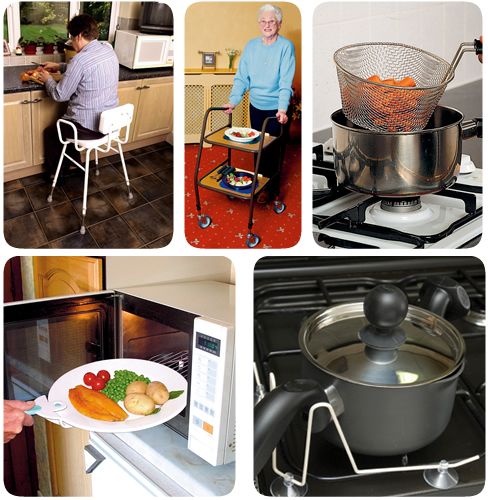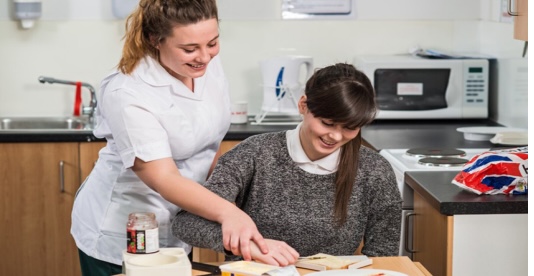Adaptive cooking is an innovative approach designed to make cooking accessible and enjoyable for everyone, regardless of physical limitations. For individuals without arms, cooking can seem challenging, but with the right techniques and tools, it can become an empowering experience. By embracing adaptive cooking techniques, one can enjoy the process of preparing meals, showcasing creativity in the kitchen, and cultivating independence.
It's essential to recognize that adaptive cooking isn't about modifying traditional recipes but rather about innovating the cooking process to suit individual needs. This means using specific strategies, equipment, and assistive devices that facilitate meal preparation. In this blog post, we will explore various adaptive cooking techniques and the tools that support this journey, emphasizing that everyone can find joy in cooking, no matter the obstacles.
Tools and Equipment for Cooking Without Arms

Equipping your kitchen with the right tools can tremendously enhance your cooking experience, especially when you're navigating the culinary world without arms. Here’s a breakdown of some essential tools and equipment that make adaptive cooking not only possible but also enjoyable:
- One-Handed Tools: These specially designed tools can be used with just one hand, which may be sufficient when your other arm is not functional. Look for items like:
- One-handed can openers
- One-handed peeler
- One-handed measuring cups
- Adaptive Cookware: Consider investing in cookware with built-in features that make handling easier, such as:
- Pans with high sides and non-slip bases
- Heavy-duty pots that stay stable on the stove
- Lightweight baking sheets with raised edges
- Kitchen Gadgets: Various gadgets can ease the cooking process:
- Automatic stirrers that do the mixing for you
- Dishwashers that handle cleanup
- Baking mats that hold items in place while cutting or mixing
- Assistive Devices: These devices can significantly enhance functionality:
- Foot-operated kitchen appliances
- Voice-activated smart appliances
- Long-handled reachers for retrieving items
Adopting these tools can transform the way you interact with your kitchen, making the art of cooking not just feasible but also fun. Remember, it’s all about personalizing your setup to fit your preferences and creativity!
Essential Techniques for Adaptive Cooking

Mastering adaptive cooking techniques opens up a world of culinary possibilities for those without arms. It's not just about making meals; it's about making cooking an enjoyable and fulfilling experience! Here are some essential techniques to consider:
- One-Handed Techniques: Utilize tools that can be operated with one hand. For instance, a cutting board with spikes or grips can hold ingredients in place while you chop or slice.
- Foot-Controlled Appliances: Take advantage of kitchen tools like foot pedals for blenders or processors. This allows you to manipulate appliances without the need for hands.
- Adaptive Utensils: Invest in specially designed utensils that feature larger grips or can be held with various parts of the body, such as a wrist or elbow. Eating aids like built-up spoons can also be helpful.
- Workstation Setup: Organize your kitchen to minimize movement. Store often-used items within reach, and use trays to keep everything you need in one place.
- Adaptive Equipment: Explore kitchen gear that can automate tasks. For example, a hands-free can opener or an electric knife can make preparation easier.
Adjusting recipes can also be essential. Instead of using traditional methods, consider alternatives like baking and slow-cooking, which require less active labor. The goal is to create a comfortable cooking environment that allows for creativity and enjoyment!
Step-by-Step Cooking Tutorials

When it comes to adaptive cooking, learning through visual aids and guided steps can make all the difference. Here’s a structured approach to tackle some delicious and straightforward recipes:
1. One-Pan Vegetable Stir-Fry
- Prep Your Ingredients: Use pre-cut vegetables or ask someone to chop them for you. If needed, employ a foot-operated food processor.
- Select Your Pan: Use a non-stick skillet to ensure easy cooking and cleanup.
- Foot-Controlled Heat: Place the skillet on the stove and use a foot pedal to turn on the heat.
- Add Ingredients: Carefully slide in your veggies using a spatula designed for one-handed use.
- Seasoning: Use a shaker for salt and spices, making it simpler to add flavor to your dish.
- Stirring It Up: A long-handled spoon can help you mix everything without too much hassle.
- Cooking Time: Once the veggies are tender, turn off the heat with your foot pedal, and you’re ready to serve!
2. Smoothie Bowl
- Gather Your Ingredients: Get some yogurt, fruits, and toppings ready. Pre-packaged fruit can save you time.
- Foot-Controlled Blender: Place ingredients into the blender jar—using a funnel can help if you’re using a one-handed method.
- Blend Smoothly: Engage the blender with a foot switch and blend until creamy.
- Pour the Mixture: Use a scoop to transfer the smoothie into a bowl.
- Add Toppings: Let your creativity run wild! Use a spoon or fingertips to sprinkle toppings like granola or nuts.
With these accessible techniques and detailed tutorials, adaptive cooking can be an exciting and liberating journey. Remember, it’s all about finding what works for you and enjoying the process!
Recipe Ideas for Adaptive Cooking
When it comes to adaptive cooking, the world of flavors and creativity is still at your fingertips, even without the use of arms. Here are some delicious and easy recipe ideas that can be tailored for anyone looking to enjoy cooking in an adaptive way:
- Smoothies and Blended Drinks: These are fantastic because they require minimal tools. Simply use a blender with a one-handed operation option. Try combining fruits like bananas and berries with yogurt or plant-based milk for a nutritious drink.
- Sheet Pan Dinners: Throw your favorite protein (like chicken or tofu) and an assortment of vegetables on a single pan, drizzle with olive oil, season, and bake. It’s easy, and clean-up is a breeze!
- Crockpot Meals: Set up your ingredients in the morning and let them slow-cook throughout the day. Recipes can include chili, soups, or stews. Just prep everything ahead of time, and you’ll have a warm meal by dinner!
- Wraps and Sandwiches: Utilize pre-sliced ingredients like deli meats, cheeses, and veggies. You can create delicious wraps or sandwiches using tortillas or bread without needing complex techniques.
- Microwave Mug Meals: Great for quick and easy single-serving meals! Combine ingredients in a microwave-safe mug, mix, and cook for a simple yet satisfying dish. Think scrambled eggs or a chocolate mug cake!
Adaptive cooking opens the door to a wealth of culinary experiences, proving that anyone can whip up something scrumptious with just a bit of creativity and resourcefulness.
Safety Tips for Cooking Without Arms
While cooking can be an enjoyable experience, safety should always be your top priority, especially when cooking without the use of arms. Here are some essential safety tips to keep in mind:
- Stabilize Work Surfaces: Ensure that your cutting boards or any prep surfaces are secure. Utilize non-slip mats to keep everything in place.
- Use Adaptive Tools: Invest in adaptive kitchen tools designed for people with limited mobility. These may include one-handed can openers, ergonomic knives, or utensil grips that promote a secure hold.
- Be Mindful of Heat Sources: Always keep pot handles turned inward to prevent accidental spills. Consider using oven mitts or heat-resistant gloves for better grip when handling hot items.
- Organize Your Workspace: Keep frequently used items within easy reach to minimize unnecessary movement. A clutter-free workspace helps prevent accidents.
- Stay Attentive: Avoid distractions while cooking. Stay focused on the task at hand. If you receive a phone call or a knock at the door, turn off any cooking appliances before attending to it.
By following these safety tips, you can create a safer cooking environment that allows you to explore your culinary skills confidently and creatively!
Community and Resources for Adaptive Cooking
When it comes to mastering adaptive cooking techniques, the support of a community and access to valuable resources can make a world of difference. This journey doesn't have to be taken in isolation; there are numerous organizations, online forums, and resources dedicated to helping individuals without arms explore their culinary skills.
*Online Communities: In today’s digital age, several forums and social media groups focus on adaptive cooking. Platforms like Facebook and Reddit have vibrant communities where members share tips, recipes, and experiences. Engaging with others who share similar challenges can provide not only inspiration but practical advice on tools and techniques that have worked for them.
Organizations and Nonprofits: Several organizations are committed to helping individuals with disabilities. For example, groups like Adaptive Cooking Programs offer workshops and classes that teach adaptive cooking techniques tailored for those with limited mobility. These programs can provide you with hands-on experience, access to adaptive equipment, and connections to other chefs.
Assistive Technology Resources: Products designed specifically for adaptive cooking can enhance your cooking experience. Websites like Caregiver Products and AdaptiveEquipment.com have comprehensive databases of tools that can help you in the kitchen. These range from one-handed can openers to specialized cutting boards and utensils that allow for greater independence.
Local Support Groups: Don't underestimate the power of local support. Many cities have organizations that organize cooking classes or social gatherings for those with disabilities. These provide not just cooking skills, but a sense of belonging and community. Check with local community centers or disability organizations to find out what’s available.
Conclusion and Encouragement
In conclusion, mastering adaptive cooking techniques is not an insurmountable challenge; rather, it’s an opportunity for creativity and empowerment. By embracing the available resources and communities, you can transform your kitchen into a space of innovation and joy. Remember, the goal isn't perfection but progress.
Celebrate the Little Wins: Every step you take in learning adaptive cooking is a victory. Whether it's mastering a new technique, discovering an adaptive tool, or successfully preparing a meal, each accomplishment builds your skills and confidence. Celebrate these moments!
Stay Curious: As you continue on this journey, maintain an open mind. Explore new recipes, experiment with flavors, and don't hesitate to make modifications that work for you. Cooking should be a fun, enjoyable experience tailored to your preferences.
Connect with Others:* Reach out to fellow adaptive cooks and share your experiences. Learning from others can provide new perspectives and can help you feel more connected. Remember, you are not alone on this journey – there’s a whole community out there rooting for your success.
In a world where culinary possibilities are infinite, mastering adaptive cooking is not just achievable, it’s a thrilling adventure waiting to unfold. Keep going—you’ve got this!










